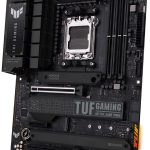The AMD X670 and X670E chipsets were announced earlier this month, with each of the leading manufacturers showcasing their flagship models. Asus was at this event, where it introduced the ROG Crosshair X670E Extreme and X670E Hero motherboards. However, the company has plans to launch other boards, including the ROG Strix X670E-E Gaming WiFi and the TUF Gaming X670E-Plus WiFi.
Starting at the top, we have the ROG Crosshair X670E Hero for those looking for a killer feature set that will likely offer more than you'll ever need. Featuring an 18+2 power phase design rated for 110A and sizable VRM heatsinks, this motherboard is ready for whichever Ryzen 7000 series chip you throw at it. Connectivity is also quite advanced, including dual rear USB4 ports, WiFi 6E, two PCIe 5.0 x16 slots, three PCIe 5.0 M.2 slots (two onboard and another from an add-in card). Other features included an integrated I/O shield, a built-in ESS ES9218PQ Quad DAC and RGB lighting.
One notch down we have the ROG Strix X670E-E Gaming WiFi, packing most of the features of the ROG Crosshair board with a few cuts here and there. The RGB lighting, 18+2 power phase design and integrated I/O shield remain.
To ensure the PCIe 5.0 SSDs don't throttle under operation, Asus's new ROG Strix X670E board comes with a hefty M.2 heatsink combo and an extra heatsink in its accessory kit. In this same kit, there are also additional M.2 thermal pads to further enhance the cooling of the SSDs.
Lastly, there's the TUF Gaming X670E-Plus WiFi with a more “basic feature set”. With that, we mean it comes with an integrated I/O shield, a single PCIe 5.0 x16 slot, and four PCIe M.2 slots (one PCIe 5.0, two PCIe 4.0 and one PCIe 3.0).
The above motherboards feature internal USB 3.2 Gen 2×2 connectors so that you can connect them to the case's front panel and a rear USB 3.2 Gen 2×2 connector (USB4 on the ROG Crosshair model). Moreover, they come with Q-Design innovations to easily dismount components, including a PCIe Q-Release button, one-sided Q-DIMM memory latching and M.2 Q-Latch.
Discuss on our Facebook page, HERE.
KitGuru says: Would you consider any of the Asus X670E motherboards for a new Ryzen 7000-based system, or would an X670 motherboard be enough for your needs?
 KitGuru KitGuru.net – Tech News | Hardware News | Hardware Reviews | IOS | Mobile | Gaming | Graphics Cards
KitGuru KitGuru.net – Tech News | Hardware News | Hardware Reviews | IOS | Mobile | Gaming | Graphics Cards



